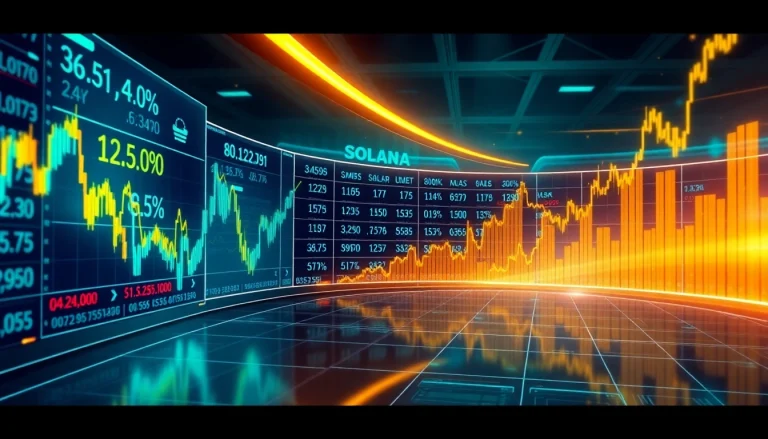
Understanding Solana and Its Market Dynamics
What is Solana?
Solana is a high-performance blockchain platform designed for decentralized applications (dApps) and crypto-currencies. Launched in March 2020 by Anatoly Yakovenko, it has quickly gained traction due to its unique mechanism of processing transactions more efficiently than its competitors, notably Ethereum. Utilizing a distinct proof-of-history (PoH) combined with a proof-of-stake (PoS) consensus, Solana can handle thousands of transactions per second (TPS) while maintaining low fees. The platform is highly regarded for its scalability and speed, serving as a prime environment for developers seeking to launch decentralized finance (DeFi) applications, non-fungible tokens (NFTs), and various blockchain-based products.
Current Solana Price USD Overview
As of the latest reports, the solana price usd is approximately $182.71, reflecting a volatile yet exciting environment for investors. The currency’s price constantly fluctuates due to several factors, including market sentiment, trading volumes, and external economic influences. Over the past 24 hours, Solana has witnessed varying activity, with notable highs and lows contributing to its trading volume, which is around $98.72 billion in total market capitalization. This active trading environment further solidifies Solana’s position as a significant player in the cryptocurrency landscape.
Market Factors Affecting Solana Pricing
Several factors play a crucial role in dictating Solana’s price movements. These factors can be categorized into macroeconomic influences, such as interest rate changes and inflation expectations, and crypto-specific dynamics, including supply and demand shifts, developer activity, and protocol upgrades. Additionally, competitive analysis reveals how Solana stacks up against its competitors like Ethereum and Cardano. Market sentiment, which includes how traders perceive the potential of Solana’s technological advancements and its adoption rates, can also lead to significant shifts in price.
Live Tracking of Solana Price USD
Where to Find Real-Time Price Updates
Real-time price updates are crucial for anyone involved in crypto trading or investment. Websites such as CoinMarketCap, Crypto.com, and Binance provide dashboards that continuously refresh the current Solana price in USD and other fiat currencies. Furthermore, popular exchanges like Kraken and Coinbase offer their users direct access to live pricing, enabling traders to make informed decisions rapidly.
Using Price Charts for Better Insights
Understanding price charts can greatly enhance an investor’s ability to predict future movements. Charts provide visual representations of Solana’s price over various time frames, allowing users to identify trends and historical patterns. Candlestick charts, for instance, offer details about open, close, high, and low trading prices, which can reveal potential resistance and support levels. Utilizing technical analysis tools with these charts can also aid in developing strategies based on moving averages, RSI (Relative Strength Index), and MACD (Moving Average Convergence Divergence) trends.
Tools and Resources for Tracking
In addition to standard exchanges and charting platforms, there are numerous tools and resources available for tracking Solana’s price and performance. Tools like TradingView provide sophisticated analysis capabilities, allowing users to customize their charts and apply various indicators. Additionally, platforms such as CoinGecko offer extensive historical data and real-time price updates alongside community-driven metrics such as sentiment scores and market cap rankings. Engaging with forums and social media can also provide insights into market sentiments that may not yet be reflected in the price.
Analyzing Solana Price Trends
Historical Price Data of Solana
Analyzing historical price data is essential to understanding Solana’s price trajectory and establishing predictive models. Solana’s price chart reveals significant events, such as rapid price surges or steep declines, often triggered by external factors like regulatory news or technological advancements. For instance, the spike in late 2021, when SOL reached its all-time highs, was significantly driven by increasing adoption and hype surrounding DeFi applications and NFTs built on the platform.
Identifying Key Price Patterns
Investors can enhance their strategies by identifying recurring price patterns. Patterns such as cup and handle, head and shoulders, and double bottoms can often signal potential market reversals or continuations. By analyzing these patterns in conjunction with technical indicators, traders can better position themselves to capture profit opportunities. Back-testing these patterns against past price movements of Solana can also provide insights into their effectiveness.
Solana Price Predictions and Analysis
Price predictions for Solana often vary widely among analysts, with many considering both fundamental analysis and technical indicators. Factors such as the growth of DeFi on Solana, upcoming technological upgrades, and overall market conditions play a significant role. Some analysts project bullish trends, predicting that Solana could potentially surpass previous highs if certain conditions—such as increased usability and strategic partnerships—are met. Others adopt a more cautious outlook, highlighting the inherent volatility of the crypto market and potential regulatory hurdles.
Impact of Global Events on Solana Price
Market Sentiment and Solana Price Fluctuations
Global events significantly impact investor sentiment, which in turn affects Solana’s price movements. Market sentiment can swing wildly due to news like regulatory changes, economic crises, or breakthroughs in blockchain technology. For instance, positive news regarding Bitcoin adoption can have a ripple effect, boosting all cryptocurrencies, including Solana. Conversely, negative events such as hacks or security breaches can lead to an erosion of trust and negative price movements.
Regulatory News Affecting Solana’s Value
Regulatory developments can have a profound impact on Solana’s pricing. Increased scrutiny from regulatory bodies can introduce uncertainty in the market, leading to short-term price declines. However, positive regulatory advances—like favorable legislation for crypto usage—can create bullish sentiment. Keeping abreast of both local and international regulatory actions is vital for investors looking to hedge against potential volatility.
Technological Advancements and Their Influence
As a blockchain platform, Solana’s technological advancements contribute significantly to its perception and price. Each upgrade aimed at improving scalability, security, or usability can lead to increased user adoption and, ultimately, price appreciation. The ongoing development of Solana’s ecosystem, including opportunities for developers to leverage DeFi and NFT protocols, affects investor confidence and trading behavior. When major improvements are announced or implemented, historical price trends suggest a tendency for positive price reactions.
Investing Strategies Surrounding Solana Price USD
When to Buy Solana: A Strategic Approach
Determining the optimal time to buy Solana requires a strategic approach involving market analysis and personal investment goals. Investors are often advised to look for dips in price as potential buying opportunities, especially following significant market corrections. Dollar-cost averaging, a strategy that involves purchasing fixed dollar amounts of Solana at regular intervals, can also mitigate risk and allow for gradual investment without the pressure of timing the market accurately.
Risk Management in Solana Investments
Effective risk management is essential to preserve capital and ensure long-term success. Key strategies include setting stop-loss orders, diversifying investments, and regularly re-evaluating one’s investment thesis as market conditions evolve. Fundamental analysis, assessing Solana’s technology, market position, and competitor landscape, also plays a critical role in determining appropriate risk thresholds.
Long-Term vs Short-Term Investment Strategies
Investing in Solana offers distinct strategies that vary based on an individual’s financial objectives and market outlook. Long-term investors may focus on the potential growth of Solana’s ecosystem, including its expanding utility and user base, while short-term traders might capitalize on market volatility, buying during price dips and selling at opportune moments. An investor’s choice of strategy should align with their risk tolerance, liquidity needs, and overall investment horizon.




